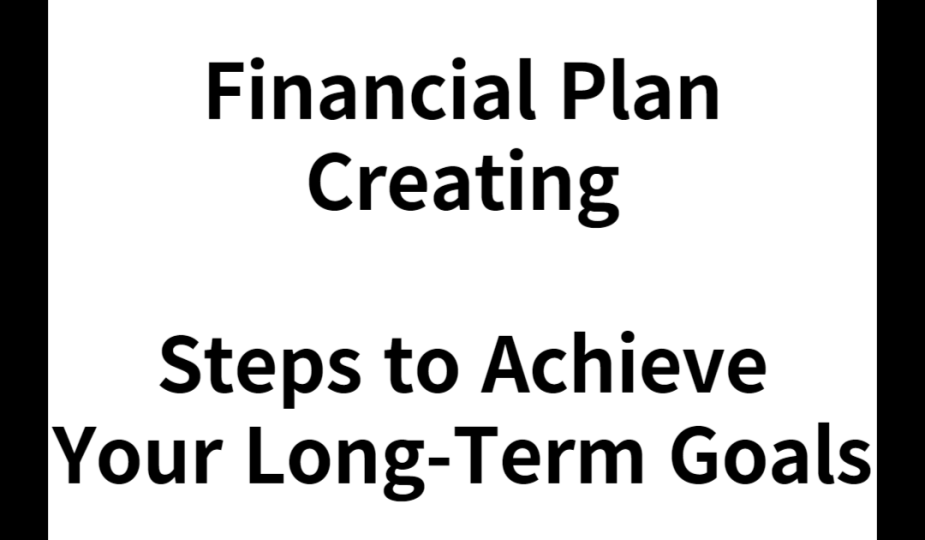Financial Plan Creating : 6 Steps to Achieve Your Long-Term Goals

Introduction
Welcome to my blog on personal finance, where I aim to provide you with advice and strategies for managing your money and achieving your financial goals.
In today’s article, we will dive into the importance of creating a financial plan to help you achieve your long-term goals.

Why Do You Need a Financial Plan?
Having a well-thought-out financial plan is crucial for a stable and secure financial future.
Whether your goals include buying a house, saving for retirement, or starting your own business, a financial plan will serve as a roadmap to guide you on your journey.
Without a clear plan in place, it becomes easy to lose track of your goals and make impulsive financial decisions.
Step 1: Define Your Financial Goals
The first step in creating a financial plan is to define your long-term goals.
Take some time to consider what you want to achieve in the next 5, 10, or even 20 years. Do you want to pay off your mortgage?
Save for your child’s education? Retire early? Write down your goals and be as specific as possible.
Step 2: Assess Your Current Financial Situation
To create an effective financial plan, you need to have a clear understanding of your current financial situation.
Start by evaluating your income, expenses, assets, and liabilities. Calculate your net worth and identify any areas of improvement or potential risks.
This assessment will help you determine where you currently stand and what steps you need to take to reach your goals.
Step 3: Create a Budget
A budget is the cornerstone of any financial plan.
It helps you track your income and expenses, identify areas where you can cut back, and allocate funds towards your goals.
When creating your budget, consider both fixed expenses (such as rent or mortgage payments) and variable expenses (such as entertainment or dining out).
Be realistic and flexible, making room for unexpected expenses or financial emergencies.
Step 4: Develop a Saving Strategy
Saving money is an essential component of any financial plan.
Once you have established your budget, determine how much you can save each month and set up automatic transfers to a dedicated savings account.
Consider creating an emergency fund to cover unexpected expenses and save for your long-term goals, such as retirement or a down payment on a house.
Aim to save at least 10-20% of your income each month.
Step 5: Manage Your Debt
Debt can hinder your progress towards achieving your financial goals.
It’s important to develop a plan to manage and reduce your debt effectively.
Start by prioritizing high-interest debts and creating a repayment strategy.
Consider consolidating your debts or negotiating lower interest rates if possible.
Make consistent payments and avoid accruing additional debt wherever possible.
Step 6: Invest for the Future
Investing your money is a powerful way to grow your wealth over time.
Explore different investment opportunities, such as stocks, bonds, mutual funds, or real estate.
Educate yourself about the risks and potential returns of each investment option, and consider seeking professional advice if needed.
Start small and gradually increase your investments as you become more comfortable.
Step 7: Regularly Review and Update Your Plan
Financial planning is an ongoing process, not a one-time event.
Set aside time regularly to review your financial plan, assess your progress, and make adjustments as needed.
Life circumstances, goals, and market conditions change over time, so it’s important to stay informed and adapt your plan accordingly.

Conclusion
Creating a financial plan is a pivotal step towards achieving your long-term goals.
By defining your goals, assessing your current situation, creating a budget, saving, managing debt, investing,
and regularly reviewing and updating your plan, you can take control of your financial future.
Remember, the journey to financial success takes time and discipline, but with a solid plan in place, you can turn your dreams into a reality.
Stay tuned for more articles on personal finance strategies and tips for maximizing your financial well-being.




Start by prioritizing high-interest debts and creating a repayment strategy.
Consider consolidating your debts or negotiating lower interest rates if possible